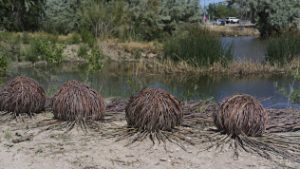
By: Bianca Greeff, Graduate Assistant.
Constructed out of old farming equipment, a rusted silhouette of a tree stands above the other vegetation. Nestled in the branches sits a bee nest. This nest creates space for pollinators specific to the Bonderman Field Station at Rio Mesa to thrive, provides researchers the opportunity to study the species, all while reminding the community of the rich ranching history of the area. This restorative sculpture, “Supporting Structures” was constructed by Wendy Wischer, assistant professor in the University of Utah’s Department of Art & Art History, in 2016.
Wischer will demonstrate the ways creative expression like “Supporting Structures” can engage individuals and communities with scientific data, and foster a connection to a place at the GCSC Seminar Series on Tuesday, Jan. 31 from 4-5 p.m. in 210 ASB.
“Recently we have been seeing more research and publications in articles and books describing the significance of the arts and how they can assist with environmental concerns,” Wischer said. “The arts are important in tackling our challenges with climate change, and sustainability as a whole.”
In her presentation, Wischer will share how her work has progressed from a symbolic practice representing the environment’s intrinsic beauty, to an activist approach designed to ignite action on environmental issues. Wischer hopes her work will create an emotional experience for the viewer, inspiring them to take personal or collective steps to maintain environmental integrity.
“It is usually our emotions that motivate us to act,” Wischer said. Those actions could “be anything from changing personal behaviors to advocating for shifts in policy.”

From joining forces with local communities and community organizations, to working alongside other University of Utah professors, collaboration is a crucial component of Wischer’s creative process. This collaboration helps Wischer engage people in social and environmental issues through her art.
“With socially engaged artwork, there are blurred lines in terms of what is art, and what is activism,” Wischer said.
In a current project along the Jordan River, Wischer is collaborating with an ecologist from the U.S. Fish and Wildlife Service, the Jordan River Commission, West Valley City, and members of the local community. The Jordan River has recently been a site of restoration. The parkway trail, garbage clean-up, and planting has made the river a great place to spend the afternoon (or the day, if you travel the entire 51 miles of the river).
Wischer is in the process of constructing sculptural elements that will help prevent bank erosion, and offer community residents a place to sit together. This restorative artwork along the bank will provide a tangible way to connect with the place, a connection that Wischer believes is vital for sustainability.
“What is really going to allow initiatives along the Jordan River to become sustainable is when the community feels connected to the river,” Wischer explained, “and they become natural stewards of the place.”
Wischer hopes her work can foster those connections that will help the Jordan River restoration thrive.
Learn more at Wischer’s lecture, “Transcending data through creative expression,” on Tuesday, Jan. 31 at 4 pm in 210 ASB.
Cover Photo: “Supporting Structures”. Courtesy of Wendy Wischer.
